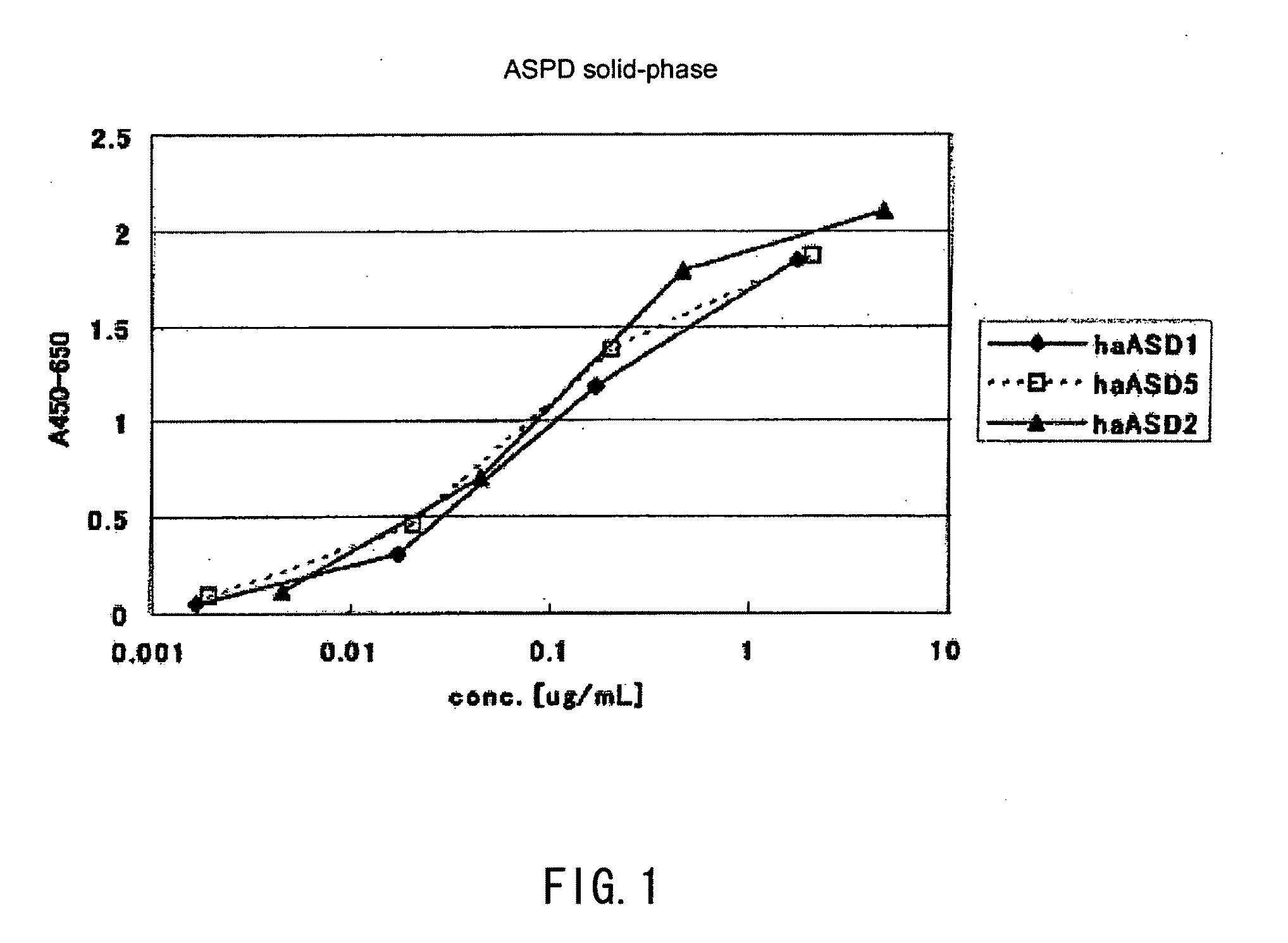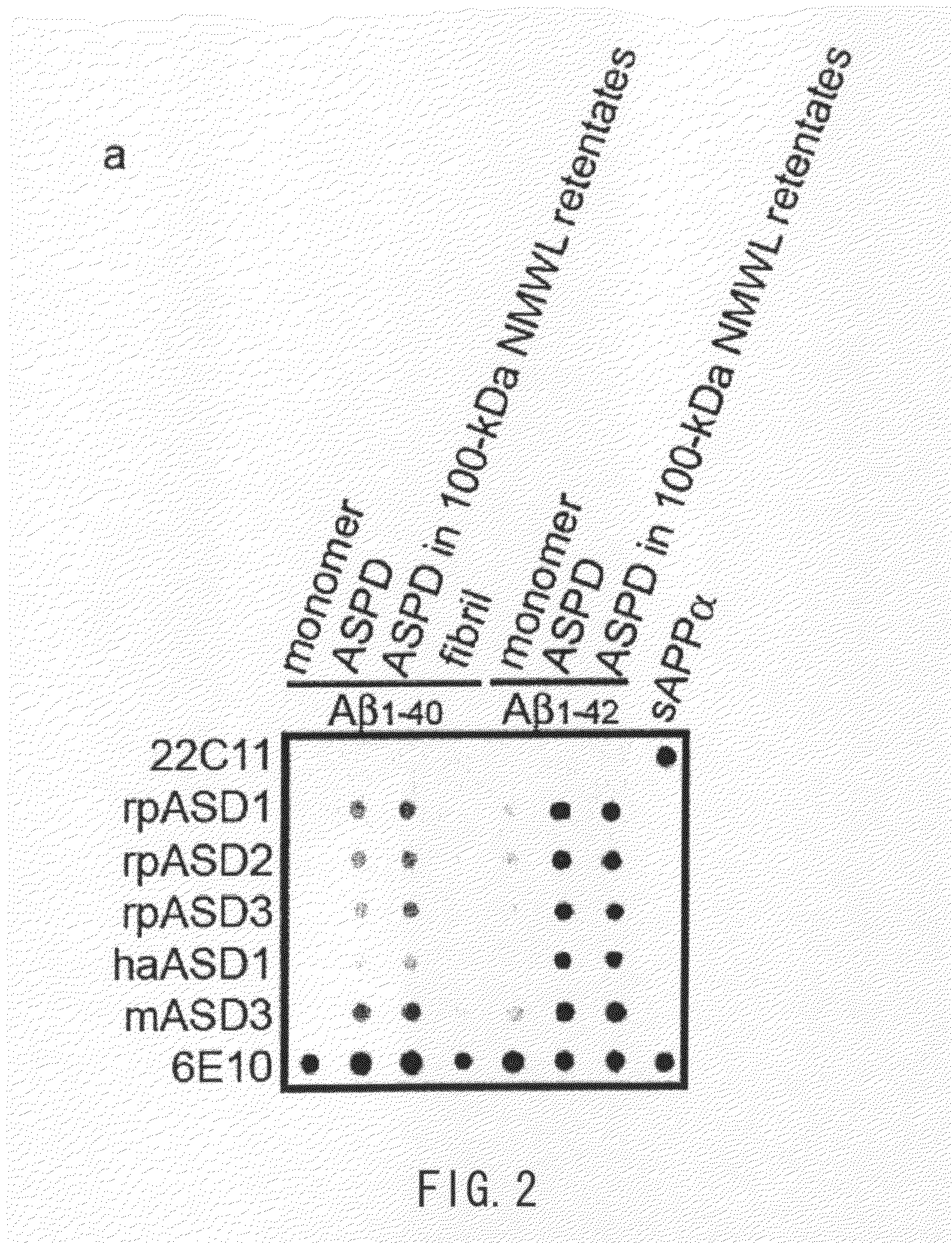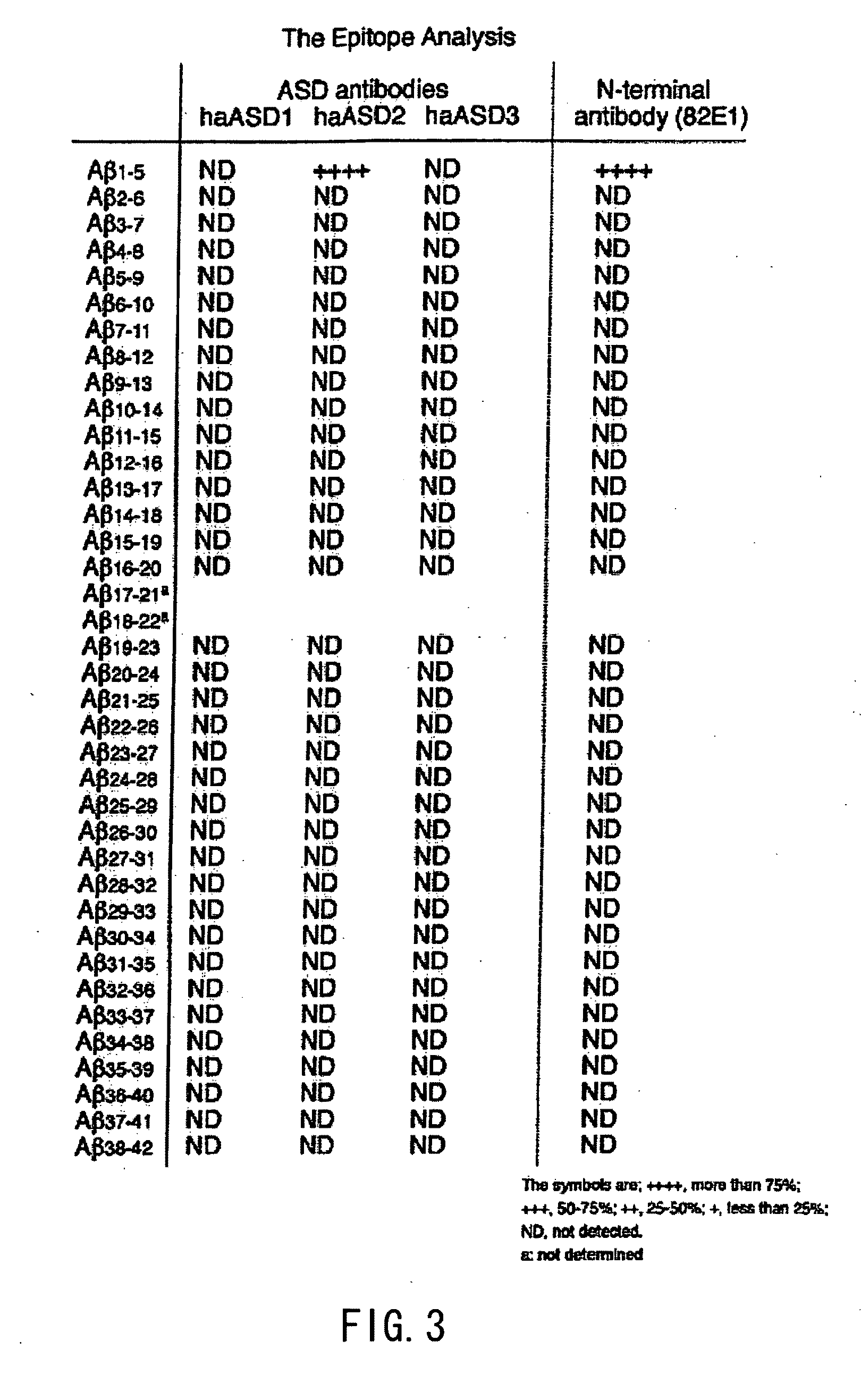Antibody and use thereof
a technology of antibody and amyloid precursor protein, applied in the field of antibodies, can solve the problems of progressive cognitive disorder of alzheimer's disease, antibody that has not yet obtained that has a low reactivity with amyloid precursor protein, and achieves the effect of inhibiting neuronal cell death, high reactivity, and low reactivity
- Summary
- Abstract
- Description
- Claims
- Application Information
AI Technical Summary
Benefits of technology
Problems solved by technology
Method used
Image
Examples
example 1
Preparation of Amylospheroid-Containing Solution
[0145](1) Production of Amyloid β40 (SEQ ID NO: 1) Resin
[0146]342 mg of Fmoc-Val resin (amine content: 0.73 mmol / g of resin) was mounted on an A433 automated peptide synthesizer (Perkin Elmer Applied Biosystems). Applied to this were Fmoc-Val-OH, Fmoc-Gly-OH, Fmoc-Gly-OH, Fmoc-Val-OH, Fmoc-Met-OH, Fmoc-Leu-OH, Fmoc-Gly-OH, Fmoc-Ile-OH, Fmoc-Ile-OH, Fmoc-Ala-OH, Fmoc-Gly-OH, Fmoc-Lys(Boc)-OH, Fmoc-Asn(Trt)-OH, Fmoc-Ser(tBu)-OH, Fmoc-Gly-OH, Fmoc-Val-OH, Fmoc-Asp(OtBu)-OH, Fmoc-Glu(OtBu)-OH, Fmoc-Ala-OH, Fmoc-Phe-OH, Fmoc-Phe-OH, Fmoc-Val-OH, Fmoc-Leu-OH, Fmoc-Lys(Boc)-OH, Fmoc-Gln(Trt)-OH, Fmoc-His(Trt)-OH, Fmoc-His(Trt)-OH, Fmoc-Val-OH, Fmoc-Glu(OtBu)-OH, Fmoc-Tyr(tBu)-OH, Fmoc-Gly-OH, Fmoc-Ser(tBu)-OH, Fmoc-Asp(OtBu)-OH, Fmoc-His(Trt)-OH, Fmoc-Arg(Pmc)-OH, Fmoc-Phe-OH, Fmoc-Glu(OtBu)-OH, Fmoc-Ala-OH, and Fmoc-Asp(OtBu)-OH, and these were successively condensed using HBTU[2-(1H-benzotriazol-1-yl)-1,1,3,3-tetramethyluronium hexafluoroph...
example 2
Preparation of Hamster Monoclonal Anti-Amylospheroid Specific Antibody
[0153]Amylospheroid 42 prepared in PBS was mixed with the equivalent amount of the complete Freund's adjuvant (WAKO) and the mixture was emulsified. 0.2 ml of the resultant mixture was administered subcutaneously in the backs of Armenian hamsters for immunization (16 μg / 0.2 ml / hamster). Amylospheroids emulsified with the incomplete Freund's adjuvant (Sigma-Aldrich) was also administered in the same manner every two weeks. After 5 immunization procedures, blood was sampled from carotid artery so that blood plasma was prepared. The blood plasma was serially diluted in a 1% bovine serum albumin (BSA, fraction V; Sigma-Aldrich) solution (in PBS(−)), and the reactivity of the anti-amylospheroid specific antibody with amylospheroids was assayed by the following solid-phase amylospheroid ELISA.
[0154]To individuals that had become to exhibit sufficiently improved reactivity as a result of 6 to 12 immunization procedures, ...
example 3
Analysis of Antibody Properties
[0158](1) Solid-Phase Amylospheroid ELISA (Analysis of Reactivity with Amylospheroids)
[0159]50 μl of amylospheroids 42 diluted to 1 μg / ml in 1 / 2-concentration PBS(−) was applied to a 96-well ELISA plate (MaxiSorp, Nunc), and the plate was subjected to overnight coating at 4° C. A 1% bovine serum albumin (BSA, fraction V; Sigma-Aldrich) solution (in PBS(−)) was added thereto at room temperature over the period of at least 1 hour so that non-specific binding sites were blocked, and the plate was washed with water. 50 μl of anti-serum or hybridoma culture supernatant diluted in a 1% bovine serum albumin solution (in PBS(−)) was added and the reaction was allowed to proceed at room temperature for at least 1 hour. The plate was washed five times with 0.05% Tween 20-containing physiological saline, a peroxidase-labeled secondary antibody diluted to 1 μg / ml (anti-hamster IgG antibodies (ROCKLAND) was also added thereto, and the reaction was allowed to procee...
PUM
| Property | Measurement | Unit |
|---|---|---|
| diameters | aaaaa | aaaaa |
| particle diameter | aaaaa | aaaaa |
| particle diameter | aaaaa | aaaaa |
Abstract
Description
Claims
Application Information
 Login to View More
Login to View More - R&D
- Intellectual Property
- Life Sciences
- Materials
- Tech Scout
- Unparalleled Data Quality
- Higher Quality Content
- 60% Fewer Hallucinations
Browse by: Latest US Patents, China's latest patents, Technical Efficacy Thesaurus, Application Domain, Technology Topic, Popular Technical Reports.
© 2025 PatSnap. All rights reserved.Legal|Privacy policy|Modern Slavery Act Transparency Statement|Sitemap|About US| Contact US: help@patsnap.com



